
ICCROM_ICS03_ReligiousHeritage_en
.pdf
7
The Most Holy Trinity worship of Vallepietra (Lazio) is a very complex religious reality,
with multiform religious ritual performances and meanings, which combine in an apparently incoherent way. Of particular interest is the spontaneous, authentically felt worship that the faithful have for the Most Holy Trinity image of the sanctuary and the deep, more or less unconscious, perception of addressing their belief in a feminine divinity.
The sacred place, very atmospheric and of extraordinary natural beauty, is an ancient cave, located 300 m from the bottom of a 1000 m long cliff face. The ritual performances, the songs, and the penitential faith of thousands of believers together create a sensation of powerful fascination. The area has been frequented for centuries: Neolithic objects have been found and, in the cave itself, the remains of an ancient Roman cult.
The devotional image of the Most Holy Trinity, not actually orthodox for the Catholic religion, is a fresco from the twelfth century AD, painted on the wall of the cave, which represents three identical figures of Christ. Thousands of pilgrims, most of them organized in ‘companies’, show deep love and gratitude for the miraculous image.
The feast is celebrated the first Sunday after the Catholic festivity of Whitsunday, on a night of the full moon, during which a passion play, ‘The Wailing of Virgins’, is performed. A second celebration is held each year on 26 July, the feast-day of Saint Anne (the mother of the Virgin Mary) who has a shrine near the holy cave. These and other ritual elements reflect the ancient pre-Roman cult of Mother Earth.
Safeguarding this religious heritage involves studying and documenting the event, and involving believers in an understanding of their ancient religious values. At the same time, it is important to realize that transformations are an unavoidable part of tradition and that the spontaneous and creative invention of culture must be supported.
[ Paola Elisabetta Simeoni]
Popular worship of the
Most Holy Trinity of Vallepietra, central Italy
the transformation of tradition and the safeguarding of intangible cultural heritage
74 Conservation of Living Religious Heritage
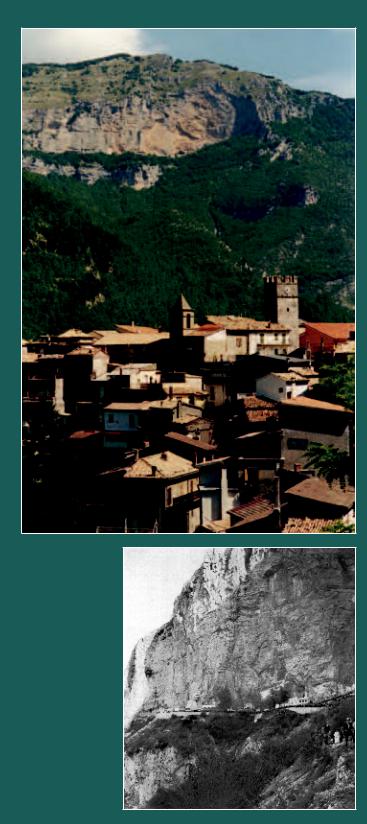
The primary purpose of this paper deals with the following subject: how to conserve and better safeguard the sacred in its intangible dimension, which is in a constant creative
flow and continually challenged by ‘glocalization’ (the dynamic exchanges between global and local patterns of culture).
This paper stresses the importance of involving the community as ‘subject’ in the conservation of its religious heritage, through understanding and documenting both intangible religious events and tangible ritual objects. It is also important to respect popular religious values during the heritage management process, and to support people’s cultural inventiveness and creativity.
A sAcred spAce, A plAce of AncienT worship
The sacred space is extremely fascinating and has extraordinary beauty. Mount Autore, at a height of 1853 m, dominates the central section of the Simbriuini Mountains. It is largely covered with centuries-old beech forest. Springs (the Simbrivio) issue from the mountainside, cutting through a great open amphitheatre of rock, and flowing past the village of Vallepietra on into the Aniene River. Within the amphitheatre is a flat area (mesa), 1,000 metres wide, supported by colossal rock towers known as Colle della Tagliata (Fig. 1).
The naked rock face here is about 300 m high. At the foot of this incredible natural apse, which is in the form of a large shell, there is a huge cave, 15 m deep, containing the sanctuary of the Most Holy Trinity (Mezzana 1943: 11–12) (Fig. 2).
This landscape, of rocky mountains, numerous springs and streams of water, has always favoured its perception as sacred and ensured a continuity of worship (Dini 1980). The remains of a Roman shrine were found in the cave, while Neolithic artefacts have been found in the surrounding area. The mountain is situated at the border of Abruzzo and is at the crossroads of three ancient cattle-tracks (tratturi) that connected the area with the Roman countryside and Campania (Fedeli Bernardini 2000: 36), more recently the Pontifical State and the Kingdom of Naples.
The sAncTuAry And sAcred imAge of The mosT holy TriniTy
The naturally formed cave has suffered from human intervention (Mezzana 1943: 16–20). It has been subdivided into a rear section called ‘the Cave of the Angel and the Holy Water’, where according to tradition an angel is said to have miraculously created a source of water with healing powers (Ciangherotti
figurE 1 the Colle della
tagliata of mount autore and
the Village of Vallepietra (archivio Etnoantropologico iCCd foto angelo Palma, 2003).
figurE 2
the sanctuary, as it was in the early 20th century (archivio fotografico storico iCCd foto luciano morpurgo, 1918).
2000: 23), and a front section, where two levels have been carved out.
On the upper floor of the front section is the present-day sanctuary, with, on the west wall, the famous fresco depicting an unusual representation of the Most Holy Trinity. Dating to the twelfth century AD,1 the fresco portrays three identical figures of Christ, bestowing blessings (in the Greek
7 • Popular worship of the Most Holy Trinity of Vallepietra, central Italy |
75 |
|
|
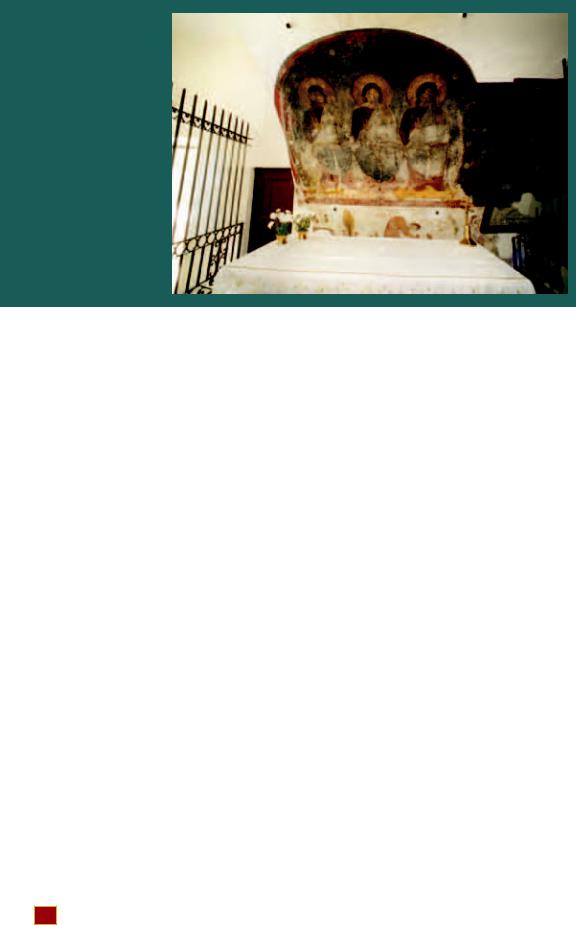
figurE 3
the holy image: la santissima trinità di Vallepietra (archivio Etnoantropologico iCCd foto angelo Palma, 2003).
manner) and holding in their left hands an open book (Zuccalà 2000: 16).2 (Fig. 3)
A chapel dedicated to Saint Anne, mother of the Virgin Mary, was built in 1888 on the left side of the sanctuary. In this chapel, there is a painting showing Saint Anne and Mary as a child, flanked by Saints Peter and John. The presence of the two saints refers to a legend about the founding of the sanctuary.3
The celebrATion of The culT
The feast of the Most Holy Trinity is a movable one,4 celebrated on the first Sunday after Pentecost, at the height of the full moon (Fedeli Bernardini 2000: 35). The feast-day of Saint Anne on 26 July is also celebrated.
The sanctuary has a vast area given over to devotional use and frequented mainly by pilgrims organized in ‘companies’ (i.e. groups), coming from towns in Lazio and the neighbouring areas of Abruzzo and Campania. It is their beliefs and customs that constitute the religious foundation of the feast. Most importantly, these are connected to the traditional popular aspects of the activities of the cult, and this usually ensures their complete autonomy from the church authorities (Cocchia 2000).5
In the past the pilgrims reached the sanctuary by foot, or on mules and asses, following ancient muletracks. Today, many of them arrive by automobile or in buses, even though over the last ten years there has been a rediscovery of the pilgrimage on foot. Many pilgrims reach the sanctuary by themselves, in family groups or with friends. Individual pilgrims and companies return more than once during the opening period of worship, which runs from the 1 May to the end of October 6 when the sanctuary is closed for the winter.
The legends of The founding of The culT
A popular legend tells of a peasant whose oxen and plough fell from the mountain above the Tagliata. He found the oxen on the surrounding mesa unharmed and in adoration in front of a cave upon whose wall appeared the mysterious fresco of the Trinity. The plough, on the other hand, remained stuck in the stone halfway down the rock wall. It was identified with a curved wooden trunk that emerged from the rocky wall (Ciangherotti 2000: 25).
In a literary account of the legend, transcribed in 1887 from an older written work dated 1735 and known
as the Papal Bull of the Trinity, two inhabitants of Ravenna, living in Rome, go to Mount Autore to escape the persecution of Nero. Here, they are visited by the apostles Peter and John, who had crossed the Kingdom of Naples. The mountain is described as sterile, without water or grass, and treeless. An angel appears to them, a spring bubbles up, and they have a vision of the Trinity in mid-air. The mountain opens, a dragon comes out and is slain by the angel. In an instant, the mountainside bursts into flower, and trees and grass flourish. The next day, the Most Holy Trinity appears and blesses the mountain as an equal to Mount Sinai and the other holy places of Palestine. This account also mentions that the spot is given over to the followers of Saint Basil, and includes a prophecy that it will be the baptismal place of the ‘Great Tartar’ (Caraffa 1959: 220; Fedeli Bernardini 2002: 53–54).
A third legend is recounted in Vallepietra and Subiaco: the ‘Three Persons’ of the Most Holy Trinity arrive in Subiaco, lodging in a village inn. The next day they leave, taking the road towards the sanctuary. They rest for a while against a tree, whose branches are on three occasions cut down by the inhabitants of Subiaco; and then the ‘Three Persons’ finally reach the holy cave (Fedeli Bernardini 2002: 37).7
The documenTed hisTory of The culT
A document dated 1079 (Caraffa 1969: 217ff.)8 states that the Church of Most Holy Trinity of Mount Autore was a part of the feudal lands of the Benedictine Monastery of Subiaco. Already, in 1294, it appears that this church was under the authority
76 ConservATIon of LIvInG reLIGIous HerITAGe
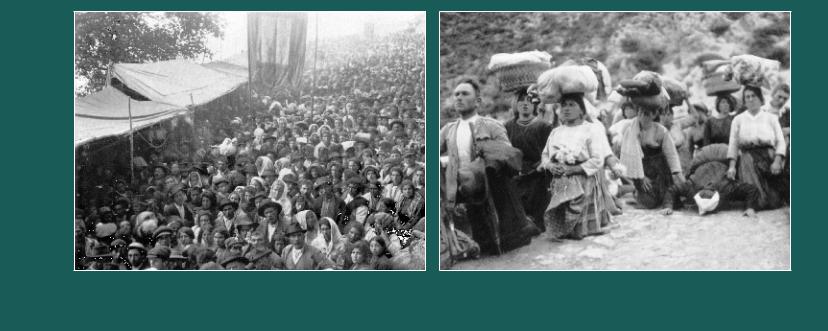
of the Bishop of Anagni. For the period between the fourteenth and sixteenth centuries, there is very little information.
In the seventeenth century, records show that the church of the ‘Santissima’ had been an abbey. Its importance seems to have grown. In documents from the eighteenth century we finally find a mention of the important influence of the pilgrims, many coming from the Kingdom of Naples.
A document of 1705 briefly describes the cult: ‘the priests of Vallepietra, accompanied by the people, climb in a procession to the sanctuary, where the mass is celebrated ‘con canto’ (with song) on an altar placed outside the church to make it easier for the faithful to get there’ (Caraffa 1969: 233).
Finally, the description left to us in 1759 from the then Bishop of Anagni, reports that the cult was celebrated on the night before the feastday of the Most Holy Trinity with the pilgrims who arrived in great numbers from the countryside and the Kingdom of Naples. They climbed the stairs of the church on their knees, in an expression of devotion as is done on the Holy Stairs (of Rome). The faithful had the custom of touching the walls of the cave. There was also another door from which the faithful left without disturbing those who entered (Caraffa 1969: 273–75). In the 1800s the importance of the sanctuary grew progressively. (Fig. 4) A document of 1854 records that ‘it is continuously visited by the devotees and especially, on the feast day, there being a crowd of eight thousand or ten thousand people, in the main, from the nearby Kingdom of Naples’ (Caraffa 1969: 242). The sanctuary became an ever-
greater source of wealth from offerings, monies left by the devoted to the church, ex-voto, donations, etc. In 1856 was begun, in fact, the present construction of the Church of Mount Autore was begun in 1856 and carried out in Neo-Classical style with a balcony and railing. In 1882 a pilgrimage is documented for the first time on the feast of Saint Anne, whose small chapel, dug out from the rock, was built in 1888.9
The Pilgrimage
The pilgrims leave from their villages and follow a standard route, with the image of the Most Holy Trinity of the sanctuary (the three identical Christs) or other images of the Trinity, or in some cases with images of Saint Anne. In the past, it might have been a beech branch, divided in three ‘fingers’. The pilgrimage can sometimes last five or more days, and for the most part is on foot. They walk through the mountains and the beech woods, crossing streams of water, and singing the traditional pilgrim hymns to the Most Holy Trinity (known as the Treppe, an abbreviation for the Tre Persone – ‘Three Persons’).10 (Fig. 5)
Following the traditional itinerary, they eat and sleep in the mountain, where they light bonfires. Others rest in the streets of the village or are given hospitality by the villagers. They sing and dance popular musical repertories, accompanied by accordions, brass and woodwind instruments, and sometimes bagpipes.
The main part of the worship is celebrated for three days, beginning two nights before the feastday, the last day being the feast of The Holy Trinity.
figurE 4 the crowd of pilgrims at the sanctuary in the early twentieth century (archivio fotografico storico -iCCd – foto luciano morpurgo, 1920-23) figurE 5 Pilgrims passingRenzio bridge. ritual behaviours (archivio fotografico storico iCCd foto luciano morpurgo, 1937?).
7 • Popular worship of the Most Holy Trinity of Vallepietra, central Italy |
77 |
|
|

The arrival of the companies takes place almost uninterrupted during the day and the night. Some of these,11 passing through Vallepietra, stop at the village church, where a painting that represents the image of the ‘Three Persons’ is hung. They make their devotions, praying, singing, and walking by the image, which they touch with their hands, or rub with a handkerchief or hat, as if to capture part of its holiness. Imparting kisses, they then implore its blessings.12 (Fig. 6)
Some companies then return home. Others proceed towards the sanctuary following a path that was used before the modern road was constructed. (Fig. 7) This is a mule-track that begins in the lower part of the village and, running along the cemetery (where the pilgrims first stop), rises to a flatland among cultivated fields, pastures, springs, small streams and waterfalls. In the second section, the track rises steeply to the Tagliata.
Reaching the sanctuary and without stopping to rest, they queue up behind their standard to go into the sacred temple and to pay homage to the Most Holy Image. (Fig. 8) Each company competes to distinguish itself from the others. The men wear handkerchiefs on their necks and brightly coloured hats. Proudly carrying the standards, they sing the hymn to the Treppe. Each company has its own particular version of the hymn, as well as a particular blend of musical instruments. They go up and down the stairs of the sanctuary three times, passing before the Holy Image in the cave, some barefoot and/or kneeling, as in ancient times. (Fig. 9)
Before entering, at the foot of the stairs, they dip their fingers in the healing water to sign themselves with the sign of the Cross. Until a few years ago the special water was placed outside the Cave of the Angel. Still praying and singing, they then enter the shrine, touching with their hands the lintel of the door. Some of them rub their fingers along the wall of the cave. There are old graffiti on the cave wall, and until a few years ago there were also votive offerings and old lamps hung from the ceiling. In front of the image they stop for a while. Most of them show deep emotion and expressions of love, some bursting unrestrainedly into tears, while others clasp the railing of the shrine and cry for mercy, exalting the Most Holy Trinity. Almost all of them leave some money offerings. Some bring votive offerings or flowers that they have brought from far away. (Figs. 10 and 11)
The companies or single pilgrims pay the priests to celebrate a mass for the souls of their dead relatives and, after they have gone to confession, they attend church services. They then buy souvenirs from the numerous stalls, especially gaily-coloured paper flowers and medals with the Three Person images.
These can be put on their hats, pilgrim-sticks or the standard of the company. They also collect a special plant with a plume (pelucche), which can be found only in that season in a particular mountain ravine. (Figs. 12–15)
Some companies sleep in the sacred place of the sanctuary,13 some in the area outside it, in the beech woods in the mountains above the Tagliata, and some in the streets of Vallepietra, or near the village where they pitch their tents or sleep on the ground. There, the pilgrims light fires, eat, drink wine and sing, playing their musical instruments. Singing and drinking, they enter into competition and may become extremely drunk.14
Finally, they return home, travelling over the ancient path or streets again. Along the way, the pilgrims stop on some occasions to rest. One of the rest stops, where the steepest climb begins, is a bridge over the waters of the Simbrivio. There some of them, following tradition, toss stones into the water to liberate themselves from their sins, pronouncing the ritual chant: a balle li peccati mei (down away my sins).
Others form family-like relationships in the water of the stream. These are rarely seen. They follow a precise ritual, crossing their fingers in the water, pronouncing the ‘Credo’, they sign each other with the sign of the Cross and promise eternal friendship. (Fig. 16) When they reach their villages, the inhabitants who had not participated in the pilgrimage welcome them up to the church where the standard is lodged near the altar.15
The piAnTo delle ZiTelle
(The wAiling of The spinsTers)
At dawn on the feast of the Trinity, there is a sung performance of the passion of Christ. This is known as the Pianto delle Zitelle (the Wailing of the Spinsters) and has been included in the cult since the second half of the nineteenth century (Cocchia 2000).16 (Fig. 17)
The Pianto can be viewed as ‘the confirmation of a pre-Christian substratum of the worship-rites included in a funeral context’ (Migliorini 1999: 76). It is sung in its entirety, in the contemplative form of a prayer rather than as true narrative (Colacicchi 1936: 3). According to Migliorini, ‘there is an organic relationship between funeral rituals and agrarian rituals: ‘wailing’, purification, orgiastic behaviour, joyfulness, penance, branches pulled up, people and means of transportation decorated with multicoloured flowers’ (Migliorini 1999: 77).17
Fourteen young girls (spinsters, i.e. virgins) of Vallepietra, dressed in white, except for the one in black representing the Madonna, sing the Pianto.
78 ConservATIon of LIvInG reLIGIous HerITAGe
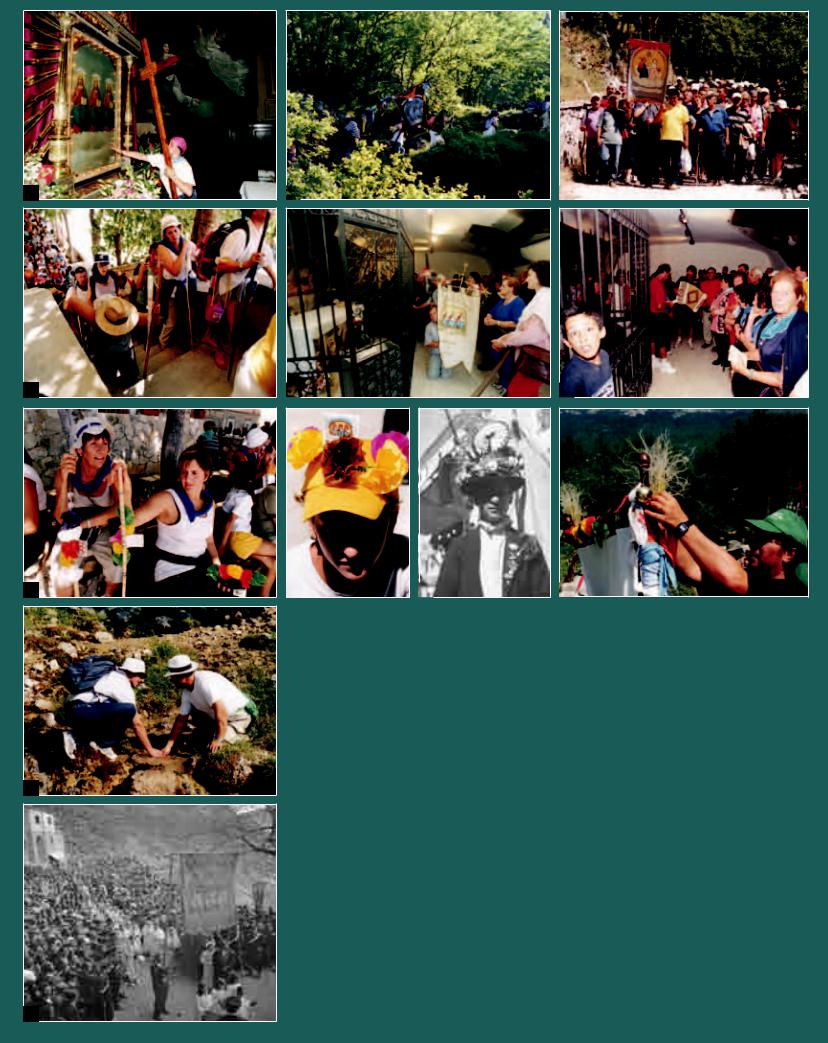
6
9
12
16
17
7 |
|
8 |
10 |
|
11 |
|
|
|
|
|
|
13 |
|
|
14 |
|
15 |
figurE 6 in the Church of Vallepietra, pilgrims perform particular rituals (archivio Etnoantropologico iCCd foto angelo Palma, 2003).
figurE 7 the ‘companies’ take a mule-track to climb towards the sanctuary (archivio Etnoantropologico iCCd foto angelo Palma, 2003).
figurE 8 thousands of pilgrims generally organized in ‘companies’ reach the sanctuary (archivio Etnoantropologico iCCd foto angelo Palma, 2003).
figurE 9 Pilgrims going up the stairs of the sanctuary (archivio Etnoantropologico iCCd foto angelo Palma, 2003).
figurE 10 and 11 Pilgrims worship before the holy image (archivio Etnoantropologico iCCd foto angelo Palma, 2003).
figurE 12 Pilgrims buy gaily coloured flowers and put them on their pilgrim sticks (archivio
Etnoantropologico iCCd foto angelo Palma, 2003).
figurE 13 …or on their hats (archivio Etnoantropologico iCCd foto angelo Palma, 2003).
figurE 14 as it was in the early twentieth century (archivio fotografico storico iCCd foto luciano morpurgo, 1937?).
figurE 15 …and collect a special ‘plume ‘(plant) (archivio Etnoantropologico iCCd foto angelo Palma, 2003)
figurE 16 Pilgrims, forming family-like relationships, cross their fingers in the water (archivio Etnoantropologico iCCd foto angelo Palma, 2003).
figurE 17 the spinsters go in procession to the balcony of the sanctuary where they perform the spinsters’ wailing (archivio fotografico storico iCCd foto luciano morpurgo, 1937?).
7 • Popular worship of the Most Holy Trinity of Vallepietra, central Italy |
79 |
|
|
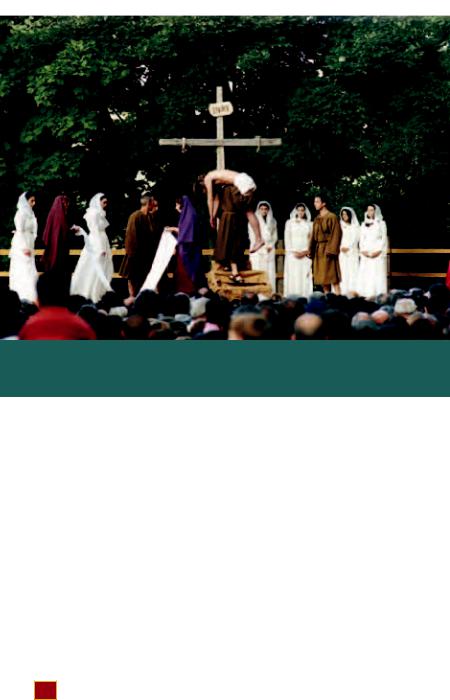
Every spinster sings her ‘Mystery’ or performs as a divine figure.18 As late as the 1950s, the sacred performance or ‘lauds’ was celebrated on the balcony of the small church of the Most Holy Trinity and acted with minimal gestures. In the 1930s it was sung in a different manner and, according to different ethnomusical hypotheses, some musical notes were similar to those of popular funeral dirges. Today, it is staged by a producer and a music-master, and performed on a platform constructed in front of the sanctuary. It is at the same time a cultural and a popular performance, which is included in a sort of liturgical framework composed by the Veni Creator and the Oremus (Cocchia 2000: 45). (Fig. 18)
figurE 18 the spinsters’ wailing is today a theatrical performance (archivio Etnoantropologico iCCd foto angelo Palma, 2003).
This musical performance probably has a medieval origin. In 2001, UNESCO proclaimed, for the first time, some of the world’s most remarkable examples of the oral and intangible heritage. One of these is the ‘Mystery Play of Elche’ in Spain, a sacred musical drama of the death, assumption and crowning of the Virgin Mary. Performed without interruption since the mid-fifteenth century, it is a living testimony of European religious theatre of the Middle Ages and of the medieval cult of devotion to the Virgin. Influenced by Byzantine rites, it is in some aspects similar to the ‘Wailing of the Spinsters’ of Vallepietra, except for the fact that the divinity worshipped is the Most Holy Trinity, though with a profound feminine perception of it (la Santissima).
The feminine perception of the worshipped divinity. The ritual complex
The Most Holy Trinity cult of Vallepietra shows a considerable degree of complexity, with various religious performances and meanings, and different ritual elements, articulated in an apparently incoherent manner from the historical, cultural and religious points of view, and defying a unitary system of comprehension.
One must note, as a very interesting and upsetting fact, that a large number of pilgrims have a more or less conscious perception of worshipping the ‘Madonna’ (the Virgin Mary).
An Italian student of history of religions, Angelo Brelich (1976), was amazed to observe that ‘though they (the pilgrims) sing hymns to the ‘Three Persons’ and cry ‘Viva la Santissima Trinità’ (‘Hurrah to the Most Holy Trinity’)… they name the worshipped divinity only as ‘la Santissima’ (the Most Holy, feminine in the Italian language)… Furthermore, they often think that they go to the pilgrimage for the glory of the Madonna’ (Brelich 1976: 76).19
Brelich charts the origins of the present cult of the Most Holy Trinity of Vallepietra to an ancient cult of the Great Earth Mother and a complex of preRoman rites with strong agrarian elements (Brelich 1976: 100–101).20
A sanctuary in a cave of a mountain and a source of water, dedicated to the ‘Santissima’ divinity, where, in a particular period of Spring and in a night of the full moon, the faithful come from a vast geographic area and where, in a particular religious occasion, a ‘Wailing’ is celebrated for a dead god. The pilgrims, returning to their villages, disguise themselves, carry trees and branches, form family-like relationships, toss stones over heaps of rocks and also toss them in the stream.’
(BreLICH 1976: 79ff.)
He compares these various elements to religious complexes of other religions of the ancient world and finds them ‘in the ancient Mediterranean world, before the cultural Hellenic hegemony…which cannot be referenced to an autonomous Mediterranean civilisation…but rather at a cultural ‘koiné’, to the formation of which Sumerian, Oriental and Occidental Semites, Aegean-Anatolian populations, and Egyptians have contributed.’21
Today, the priests deny such dedication,22 but then admit that some of the faithful say that they are going ‘to the Madonna’. They attribute this
80 ConservATIon of LIvInG reLIGIous HerITAGe
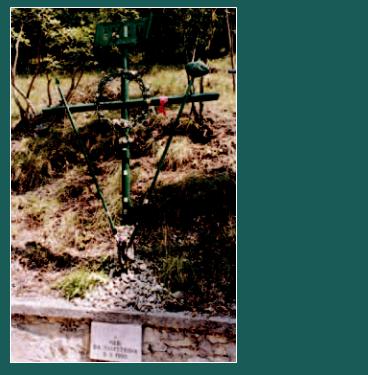
belief, above all, to those companies that come from the south (the Province of Frosinone) and suffer from confusion due to ignorance or for reasons of tradition.
Many faithful seem reticent; they know that such confusion is not well accepted by the Church. Other devotees, without embarrassment, declare that it is true, because Saint Anne is celebrated with the Trinity (and, therefore, the Virgin Mary). It is quite certain that Saint Anne also assumes on occasion the connotation of the Great Mother (Bibliotheca Sanctorum 1961: 1271).
To hear the ‘Santissima’ cited, to name the Trinity of Mount Autore, does suggest that the Trinity cult of the sanctuary underlies a more or less conscious perception of a feminine divinity to whom the cult is dedicated – a belief that is obviously officially inadmissible.
It is possible to give an historical interpretation to the religious practice of the ‘Santissima’, which probably represents the survival of an agrarian cult. It is not known whether this is directly connected to an ancient pre-Roman religious complex but surely it is linked, until recently, to peasant and local pastoral ambiences. These various cults have created, in the course of the centuries, stratifications of the rituals and various religious syncretisms. Furthermore, in the Jungian interpretation, the popular rites of the cult as a whole can be related to a cult attributed to the Great Earth Mother (Jung 1979 (original edition 1940); Neumann 1975 (original edition 1953) and 1981 (original edition 1956)).
In effect, the cult of the ‘Santissima Trinità’ and that of the Virgin Mary (today probably linked with the celebration of Saint Anne) have been juxtaposed without denying each other’s validity. In fact they tend to overlap to such a degree that they are partly confused. What can be the reason for which in the worship of the ‘Santissima’ one wails for the dead Christ? Why is it a cult of the dead?
The attempt to comprehend the apparent conflict of various ritual and worship elements, within a matrix of religious and cultural reference to the Great Mother, is, in my opinion, partly a matter of history and gender. It also illustrates how the official Church has reacted to the contradictions posed by historical and cultural traditions: the veneration of an heretical image, the feminine perception of the cult, the performance, outside the Catholic liturgical context, of the ‘Wailing of the Spinsters’23, the cult of Saint Anne and the cult of the dead.
Recent changes
Today, in a period of general transformation of society, of its values, habits and ritual practices, many
young pilgrims appear to be attracted to the possibility of hiking to the Tagliata of Mount Autore. The not so young are attracted by their vibrant devotion to a divinity still deeply venerated. They demonstrate, in their ritual Catholic gestures (the signing of the Cross, the behaviour in church, praying, etc.), their distance from the liturgical practices of the Church. Others tenaciously repeat the traditions left to them by their elders, undertaking the pilgrimage in memory of them.
The local church, on the other hand, is continuously demonstrating its ‘managerial’ capacity, providing the sanctuary with flowers, repairing the roads leading to it, and undertaking the general maintenance of the sanctuary.
Some years ago, the water source of the cave, considered to be of a healing nature, was brought to the entrance of the sanctuary by the Prior, with directions to use it only to make the sign of the Cross (indications which are often ignored by the faithful).
The crosses, which are planted in devotion by the companies in various parts of the sacred place, have been moved along the path leading to the foot of the sanctuary. Due to increasing imitation, or to competition among the companies, crosses and stone slabs have multiplied in the last few years (today their number is more than 150). (Fig. 19)
This year, the cross of Pereto (a village in Abruzzo region) was also moved to the roadside. It was considered the first and oldest, visible in the photographs of Morpurgo from the beginning of the
figurE 19
a cross (archivio Etnoantropologico iCCd foto angelo Palma, 2003).
7 • Popular worship of the Most Holy Trinity of Vallepietra, central Italy |
81 |
|
|
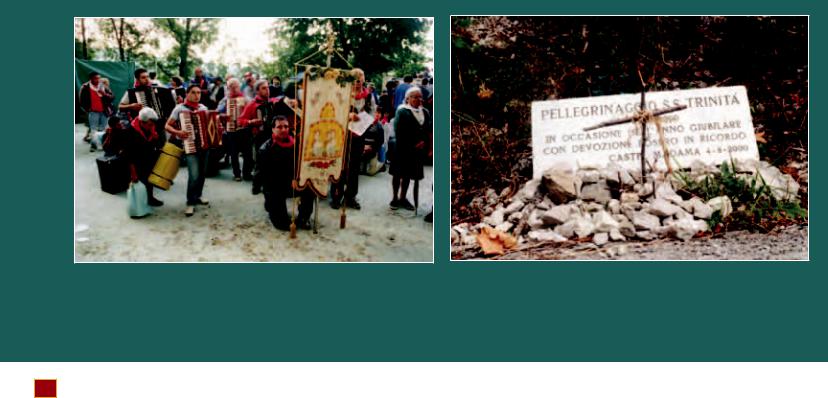
1900s. It was set in an open space along the road where the pilgrims stopped to pray and sing before it, and to toss stones and set down their candles.
In 2003, the sanctuary was also ‘cleaned’ inside by the new Prior. The ex-voto offerings, which had been hung on the walls, were removed and gathered together in a small museum underneath the sanctuary, as they were considered a distraction to the devotees. The centuries old graffiti (Mezzana 1943: 46) also disappeared under a layer of paint. 24
TrAdiTion, TrAnsformATion, sAfeguArding heriTAge
What are the consequences of this perspective for what we have briefly discussed here? What are the best ways to safeguard our intangible heritage? It is characterised by an almost non-existent tangible component, by transformation, by the fact there are living and vital cultural events in the constant, creative flow of the adaptation of people with respect to the socio-economic and religious environment in which they live.
It represents at the same time worldviews and specific cultural systems, reflecting social and human values, and singular and particular hereditary identities, all of which are fundamental to the socio-cultural survival of the community that expresses them.
An extremely rapid transformation, due to the ever increasing globalisation of the ‘market place’, accompanied by the mass cultural phenomena carried out by the communications media, produces an
insidious effect on local cultural dynamics, crashing over them in a raging flood which devastates the relationships between generations and their different perceptions, values and experiences.
The first thing for an anthropologist or ethnologist to do is to document the unique event being observed (Fig. 20). He must safeguard the memory of traditional oral and intangible culture, recording first of all the knowledge that older people still retain of their own culture, as well as the transformations observed by the younger generations. Audio and visual documentation must be undertaken, and every witness to the cultural phenomenon and data on the subject collected (bibliographic, archive, photographs, films, and audio recordings). It is important to have a convincing interpretation of the events observed and the dynamics of their transformations.
To verify continually and to monitor the continuation and the transformations is another important task of safeguarding (Tucci 2002). This is the first act of safeguarding a heritage, the most important perhaps because one must know that the event observed will change and never be the same, due both to human individual variability and to historic, social and cultural transformations. (Fig. 21)
It is fundamental that all the material collected and conserved must be divulged and communicated at different levels of social and cultural usage. The data regarding intangible heritage, in particular, have to be contained in audio and visual archives from which one can publish field research, archived studies
figurE 20 a company, walking backwards, leaves the sanctuary, playing instruments and singing hymns to theSantissima
(archivio Etnoantropologico iCCd foto angelo Palma, 2003).
figurE 21 the challenge of transformation: several ephemeral small crosses are ‘planted‘ in devotion
(archivio Etnoantropologico iCCd foto angelo Palma, 2003).
82 ConservATIon of LIvInG reLIGIous HerITAGe

or documents, and catalogues, as well as forming the basis for further research.
In Italy, to conserve data regarding cultural heritage, we use aids such as cataloguing systems,25 today managed by a computerized system known as the Sistema Informativo Generale del Catalogo (SIGEC – the General Informative System of Cataloguing) created by the Central Institute for Documentation and Cataloguing (ICCD).
To save and conserve this sort of cultural heritage, strongly tied to the everyday life of the people, is to respect them as ‘subjects’, to respect their culture, their values and feelings. This is why nothing must be done without them. They are the first owners of their cultures. When asked for information, during interviewing, filming and recording, they will remember, reflecting about themselves, creating self-observation and a self-conscious level of their cultural pattern, and so conserve their cultural performances or invent new cultural activities.
This is why I believe that one instrument of safeguarding is involving the community in conservation of religious heritage, respecting popular tradition and cultural and religious values, maintaining cultural patterns, and permitting and supporting communities in the creation of new patterns and the adaptation of current practices to the future realities.26
There are often, as we have had occasion to see, ‘strong’ interventions by the Catholic religious authorities, but also on the part of the civil authorities. How can we interpret these? Are they part of the entire picture of the event, where the religious, economic, social and political forces in the field undergo anthropological studies and consequently are allowed to ‘react within the context’? Or are they outside of the picture and therefore require action by us?
But safeguarding intangible and tangible cultural heritage is the problem of another authority, the ‘cultural’ one, which gives directions regarding the intangible heritage in order to safeguard it from extinction. Rather than a question of orthodoxy (of faith) or of political and/or economic convenience, it is a matter of sustainable development. (Fig. 22)
Conclusion
I believe it to be opportune:
•to identify rules and methodologies for intervention (or non-intervention) within popular traditions;
•to establish rules and methodologies on the basis of scientific knowledge of the phenomena and with the help and collaboration of the local population, respecting on the one hand their way of ‘feeling’ the event and on the other their will to
figurE 22 the future is just beginning
(archivio Etnoantropologico iCCd foto angelo Palma, 2003).
express themselves regarding the events, and to oppose, if necessary, that which is often imposed upon the community by the outside world, the Church, etc.
•to ensure that the cultural authority (or authorities) identifies pilot projects as methodological and scientific points of reference and develops an
ethical and institutional code of conduct. Dealing with intangible heritage, whose fragility
is well known, and the practice of safeguarding, implies not intervening in cultural religious dynamics with actions that are the result of authoritarian external impositions.
Scientific and well-documented knowledge of the beliefs, rituals and religious events and subsequently of tangible sacred objects or instruments of cult, deeply respecting the local people’s values, is, I believe, the main path to conserving the sacred. Their historical, social and cultural transformation, if periodically monitored, can be an important method for discovery the rules of safeguarding religious heritage. Last but not least, the training of a team of experts should be the method for carrying out the rules for good cultural practices.
Bibliography
Brelich, A. (1976), ‘Un culto preistorico vivente nell’Italia centrale’, in D. Carpitella (ed.) Folklore e analisi differenziale di cultura (Rome: Bulzoni Editore), 71–101.
Bibliotheca Sanctorum (1961), ‘Anna’, vol. I (Pontificia Università Lateranense).
Caraffa, F. (1969), Vallepietra dalle origini alla fine del secolo XIX. Con un’appendice sul santuario della Santissima Trinità del Monte Autore (Lateranum Roma).
7 • Popular worship of the Most Holy Trinity of Vallepietra, central Italy |
83 |
|
|
